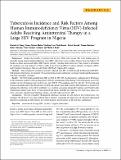| dc.contributor.author | Chang, Charlotte A. | en_US |
| dc.contributor.author | Meloni, Seema Thakore | en_US |
| dc.contributor.author | Eisen, Geoffrey | en_US |
| dc.contributor.author | Chaplin, Beth | en_US |
| dc.contributor.author | Akande, Patrick | en_US |
| dc.contributor.author | Okonkwo, Prosper | en_US |
| dc.contributor.author | Rawizza, Holly E. | en_US |
| dc.contributor.author | Tchetgen Tchetgen, Eric | en_US |
| dc.contributor.author | Kanki, Phyllis J. | en_US |
| dc.date.accessioned | 2015-12-04T18:14:39Z | |
| dc.date.issued | 2015 | en_US |
| dc.identifier.citation | Chang, Charlotte A., Seema Thakore Meloni, Geoffrey Eisen, Beth Chaplin, Patrick Akande, Prosper Okonkwo, Holly E. Rawizza, Eric Tchetgen Tchetgen, and Phyllis J. Kanki. 2015. “Tuberculosis Incidence and Risk Factors Among Human Immunodeficiency Virus (HIV)-Infected Adults Receiving Antiretroviral Therapy in a Large HIV Program in Nigeria.” Open Forum Infectious Diseases 2 (4): ofv154. doi:10.1093/ofid/ofv154. http://dx.doi.org/10.1093/ofid/ofv154. | en |
| dc.identifier.issn | 2328-8957 | en |
| dc.identifier.uri | http://nrs.harvard.edu/urn-3:HUL.InstRepos:23845308 | |
| dc.description.abstract | Background. Despite the benefits of antiretroviral therapy (ART), tuberculosis (TB) is the leading cause of mortality among human immunodeficiency virus (HIV)-infected persons in Africa. Nigeria bears the highest TB burden in Africa and second highest HIV burden globally. This long-term multicenter study aimed to determine the incidence rate and predictors of TB in adults in the Harvard/AIDS Prevention Initiative in Nigeria (APIN) and President's Emergency Plan for AIDS Relief (PEPFAR) Nigeria ART program. Methods. This retrospective evaluation used data collected from 2004 to 2012 through the Harvard/APIN PEPFAR program. Risk factors for incident TB were determined using multivariate Cox proportional hazards regression with time-dependent covariates. Results. Of 50 320 adults enrolled from 2005 to 2010, 11 092 (22%) had laboratory-confirmed active TB disease at ART initiation, and 2021 (4%) developed active TB after commencing ART. During 78 228 total person-years (PY) of follow-up, the TB incidence rate was 25.8 cases per 1000 PY (95% confidence interval [CI], 24.7–27.0) overall, and it decreased significantly both with duration on ART and calendar year. Risk factors at ART initiation for incident TB included the following: earlier ART enrollment year, tenofovir-containing initial ART regimen, and World Health Organization clinical stage above 1. Time-updated risk factors included the following: low body mass index, low CD4+ cell count, unsuppressed viral load, anemia, and ART adherence below 80%. Conclusions. The rate of incident TB decreased with longer duration on ART and over the program years. The strongest TB risk factors were time-updated clinical markers, reinforcing the importance of consistent clinical and laboratory monitoring of ART patients in prompt diagnosis and treatment of TB and other coinfections. | en |
| dc.language.iso | en_US | en |
| dc.publisher | Oxford University Press | en |
| dc.relation.isversionof | doi:10.1093/ofid/ofv154 | en |
| dc.relation.hasversion | http://www.ncbi.nlm.nih.gov/pmc/articles/PMC4654399/pdf/ | en |
| dash.license | LAA | en_US |
| dc.subject | antiretroviral therapy | en |
| dc.subject | HIV | en |
| dc.subject | incidence | en |
| dc.subject | Nigeria | en |
| dc.subject | tuberculosis | en |
| dc.title | Tuberculosis Incidence and Risk Factors Among Human Immunodeficiency Virus (HIV)-Infected Adults Receiving Antiretroviral Therapy in a Large HIV Program in Nigeria | en |
| dc.type | Journal Article | en_US |
| dc.description.version | Version of Record | en |
| dc.relation.journal | Open Forum Infectious Diseases | en |
| dash.depositing.author | Tchetgen Tchetgen, Eric | en_US |
| dc.date.available | 2015-12-04T18:14:39Z | |
| dc.identifier.doi | 10.1093/ofid/ofv154 | * |
| dash.contributor.affiliated | Tchetgen Tchetgen, Eric | |


